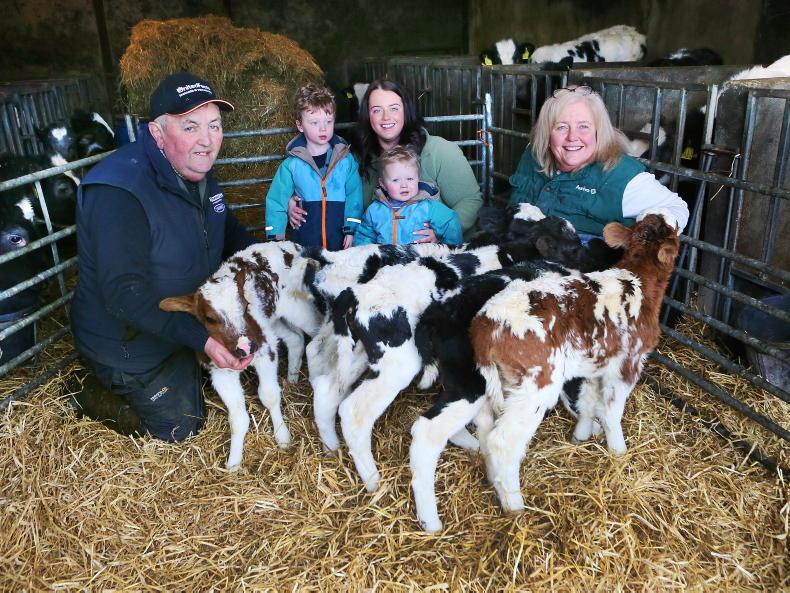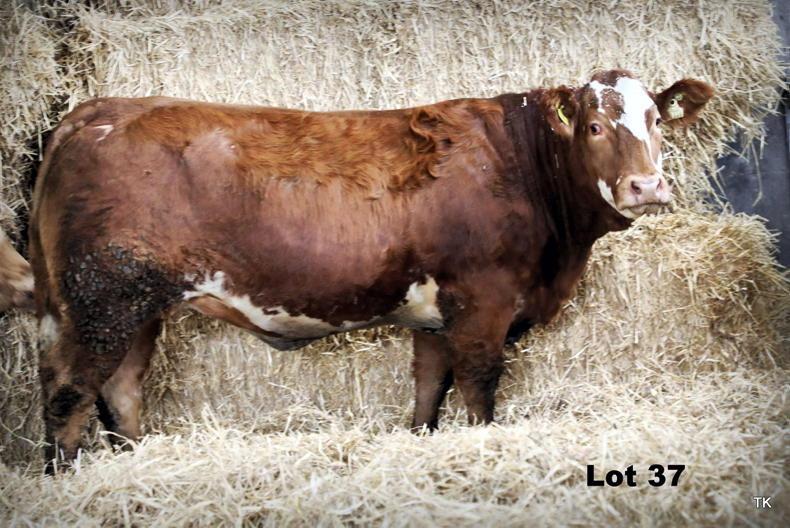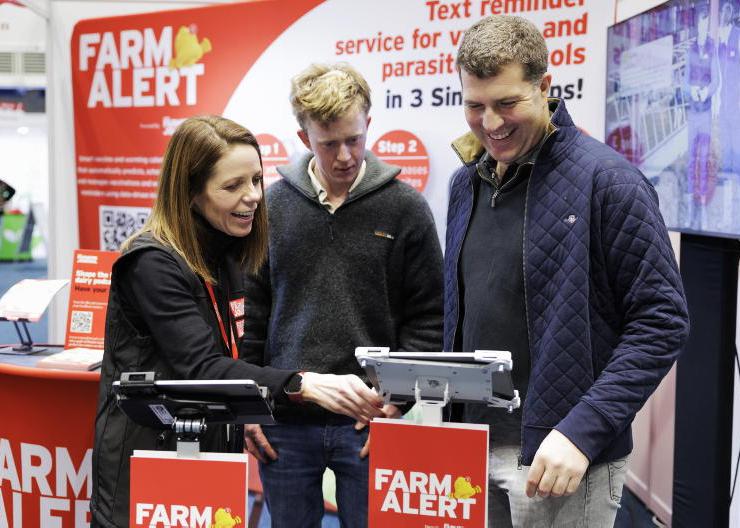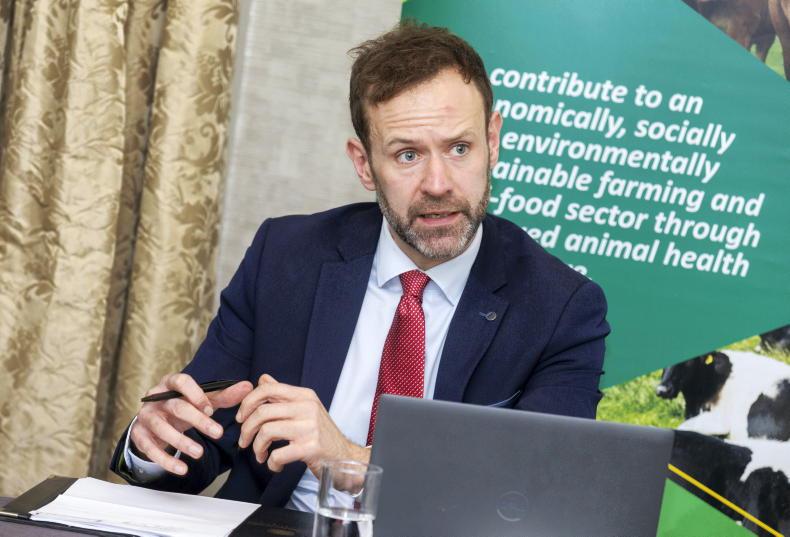The Jalex Herd is owned and run by James and Nelson Alexander. The herd is made up of both pedigree and commercial cattle on 900 acres near Toome, Co Antrim. The main farm enterprise is selling in-calf females.
In March 2015, James sold his commercial herd of 500 cows. Before this, James’s father Nelson hosted a sale of 100 cows and calves in August of each year. James had intended to get into slaughtering cattle, but because they had the name for selling quality breeding stock they were inundated with phone calls looking for breeding females and that’s when they made the decision to begin selling in-calf heifers.
James now carries 950 to 1,000 females in the herd with 18 to 20 stock bulls being used. Heifers are bought into the herd from 250kg to 550kg, with quality being the driving factor. Heifers are purchased from all over the country, both north and south. Breeds of heifers purchased are Limousins, Simmentals, Charolais, Shorthorns and Angus.
Speaking about the heifers, James says: “Good heifers can be hard to find. My ideal heifer is square, breedy and soft. We try our best to provide top-quality heifers to the average suckler farmer.”
Listen to an interview with James in our podcast below:
Listen to "James Alexander explains how he manages the nearly 1,000 in-calf heifers on his farm" on Spreaker.
All heifers are grouped in lots depending on weight and colour. Bulls are then matched to certain batches of heifers. “The more heavily muscled heifers are matched with easier-calving breeds while the more square heifers are let go with other breeds. I have 320 heifers with bulls at the minute. These will all be sold this autumn,” James adds.
The majority of these in-calf heifers are sold at home, usually through repeat customers with whom James has developed a strong relationship with over the years. However, every year, many new customers also buy stock. Each year depends on the demand and sometimes James has an auction to sell some of the heifers. James aims to sell the heifers every year, shortly after the weanling sales in October.
“The demand last year was unbelievable. I never expected it at all.”
Due to the large number of cattle on the farm, great time and effort has gone into designing a herd health programme that works for both James and his customers.
“Previously, all stock were tested for BVD before entry to the herd, but with the eradication programmes both north and south, there is no longer a need to test although all stock are still vaccinated. Cattle are also routinely vaccinated for IBR, as well as being fluked and wormed.”
Stock bulls used in the herd are Limousin, Simmental, Shorthorn and Angus. These bulls are purchased at sales such as Roscrea, Stirling and Carlisle and they are also purchased privately.
“I use stock bulls for two reasons. Firstly, our farm is so spread out and, secondly, I’d rather invest more money in top-quality bulls than spend it on straws from AI companies,” says James.
Semen is also sold from the Jalex Herd. “In the past few years, I have sold a lot of semen from a number of bulls including Swarland Eddie. His semen sold extremely well both at home and abroad and is now fully sold out,” James says.
Pedigree stock
Over the years, James has turned his hand to a number of pedigree breeds including Limousins, Shorthorns, Belgian Blues, Angus, Simmental and Maine Anjous. Last year, James purchased Limousin heifer Trueman Isabella and, to date, has four calves on the ground from her with all doing extremely well. Isabella stems from the renowned show champion Trueman Euphonium who was crowned champion at the 2011 National Limousin Show. James looks for power, plates and muscle in his Limousins.
While hopefully expanding his Limousin pedigree herd to around 15 cows, James also hopes to build up his pedigree Shorthorn and Angus herds. Speaking on traditional breeds, James remarks: “For a man who’s really into muscle, I think native breeds are the future. They require less input, less concentrates and have more utilisation from grass. I used a Shorthorn bull on a bunch of my Simmental heifers last year and the calves were beautiful. They are ideal replacements, they are soft and square with power.”
Speaking about his select Belgian Blue herd, James believes in big-framed Blue cattle. “I think the breed has a future but they are going to have to get better on the legs and they need to be bigger, scopier types of cattle.
“Because I need so many bulls, I’m trying to breed bulls to my own requirements so I’m looking for shape, softness and plates. I’m not a fan of figures. I believe in judging the animal on its appearance and its pedigree history.”
Each year, James flushes his top pedigree cows. However, he feels it is only recently that he is able to put the time and effort into his pedigrees now that all of his commercial cows are gone. Last year, James flushed his best Belgian Blue cow and after getting no fertile eggs, made to decision to try IVF. This was a success, with the first IVF eggs being implanted last Friday. “The cow wouldn’t flush so I decided to try IVF and luckily I got nine fertile eggs. However, this is an expensive route,” James adds.
While showing would have been a big part of the farm, in recent years it has taken a back seat. “In 2013, we had a brilliant year showing. We were fortunate enough to win every summer show that we attended including Balmoral, Northern Ireland commercial cattle exhibitors’ club show and Allams. That was the last year we showed commercial, but this year I intend on showing some of the pedigrees.”
James also has 550 ewes and he retains all of the previous year’s ewe lambs. All the ewes are Cheviot mules, tipped with Suffolk rams bought in Kelso. These rams contain a quarter or half New Zealand blood in them, with the aim of producing replacement ewe lambs.
Alongside the farming enterprise, James and his father Nelson run a machinery and tractor sales business which also sells commercial vehicles.
“In the future, I hope to go in the same direction if the demand is still there. I want to keep satisfying my customers with top-quality heifers. I also want to continue breeding pedigree animals while striving to improve the quality of the herd,” James says.
900 acres being farmed (700 owned and 200 leased).950 to 1,000 cattle. Main enterprise: selling in-calf heifers.Pedigree cattle: flushes them, uses IVF and sells semen.550 ewes.Machinery and tractor sales.Commercial vehicle sales.
The Jalex Herd is owned and run by James and Nelson Alexander. The herd is made up of both pedigree and commercial cattle on 900 acres near Toome, Co Antrim. The main farm enterprise is selling in-calf females.
In March 2015, James sold his commercial herd of 500 cows. Before this, James’s father Nelson hosted a sale of 100 cows and calves in August of each year. James had intended to get into slaughtering cattle, but because they had the name for selling quality breeding stock they were inundated with phone calls looking for breeding females and that’s when they made the decision to begin selling in-calf heifers.
James now carries 950 to 1,000 females in the herd with 18 to 20 stock bulls being used. Heifers are bought into the herd from 250kg to 550kg, with quality being the driving factor. Heifers are purchased from all over the country, both north and south. Breeds of heifers purchased are Limousins, Simmentals, Charolais, Shorthorns and Angus.
Speaking about the heifers, James says: “Good heifers can be hard to find. My ideal heifer is square, breedy and soft. We try our best to provide top-quality heifers to the average suckler farmer.”
Listen to an interview with James in our podcast below:
Listen to "James Alexander explains how he manages the nearly 1,000 in-calf heifers on his farm" on Spreaker.
All heifers are grouped in lots depending on weight and colour. Bulls are then matched to certain batches of heifers. “The more heavily muscled heifers are matched with easier-calving breeds while the more square heifers are let go with other breeds. I have 320 heifers with bulls at the minute. These will all be sold this autumn,” James adds.
The majority of these in-calf heifers are sold at home, usually through repeat customers with whom James has developed a strong relationship with over the years. However, every year, many new customers also buy stock. Each year depends on the demand and sometimes James has an auction to sell some of the heifers. James aims to sell the heifers every year, shortly after the weanling sales in October.
“The demand last year was unbelievable. I never expected it at all.”
Due to the large number of cattle on the farm, great time and effort has gone into designing a herd health programme that works for both James and his customers.
“Previously, all stock were tested for BVD before entry to the herd, but with the eradication programmes both north and south, there is no longer a need to test although all stock are still vaccinated. Cattle are also routinely vaccinated for IBR, as well as being fluked and wormed.”
Stock bulls used in the herd are Limousin, Simmental, Shorthorn and Angus. These bulls are purchased at sales such as Roscrea, Stirling and Carlisle and they are also purchased privately.
“I use stock bulls for two reasons. Firstly, our farm is so spread out and, secondly, I’d rather invest more money in top-quality bulls than spend it on straws from AI companies,” says James.
Semen is also sold from the Jalex Herd. “In the past few years, I have sold a lot of semen from a number of bulls including Swarland Eddie. His semen sold extremely well both at home and abroad and is now fully sold out,” James says.
Pedigree stock
Over the years, James has turned his hand to a number of pedigree breeds including Limousins, Shorthorns, Belgian Blues, Angus, Simmental and Maine Anjous. Last year, James purchased Limousin heifer Trueman Isabella and, to date, has four calves on the ground from her with all doing extremely well. Isabella stems from the renowned show champion Trueman Euphonium who was crowned champion at the 2011 National Limousin Show. James looks for power, plates and muscle in his Limousins.
While hopefully expanding his Limousin pedigree herd to around 15 cows, James also hopes to build up his pedigree Shorthorn and Angus herds. Speaking on traditional breeds, James remarks: “For a man who’s really into muscle, I think native breeds are the future. They require less input, less concentrates and have more utilisation from grass. I used a Shorthorn bull on a bunch of my Simmental heifers last year and the calves were beautiful. They are ideal replacements, they are soft and square with power.”
Speaking about his select Belgian Blue herd, James believes in big-framed Blue cattle. “I think the breed has a future but they are going to have to get better on the legs and they need to be bigger, scopier types of cattle.
“Because I need so many bulls, I’m trying to breed bulls to my own requirements so I’m looking for shape, softness and plates. I’m not a fan of figures. I believe in judging the animal on its appearance and its pedigree history.”
Each year, James flushes his top pedigree cows. However, he feels it is only recently that he is able to put the time and effort into his pedigrees now that all of his commercial cows are gone. Last year, James flushed his best Belgian Blue cow and after getting no fertile eggs, made to decision to try IVF. This was a success, with the first IVF eggs being implanted last Friday. “The cow wouldn’t flush so I decided to try IVF and luckily I got nine fertile eggs. However, this is an expensive route,” James adds.
While showing would have been a big part of the farm, in recent years it has taken a back seat. “In 2013, we had a brilliant year showing. We were fortunate enough to win every summer show that we attended including Balmoral, Northern Ireland commercial cattle exhibitors’ club show and Allams. That was the last year we showed commercial, but this year I intend on showing some of the pedigrees.”
James also has 550 ewes and he retains all of the previous year’s ewe lambs. All the ewes are Cheviot mules, tipped with Suffolk rams bought in Kelso. These rams contain a quarter or half New Zealand blood in them, with the aim of producing replacement ewe lambs.
Alongside the farming enterprise, James and his father Nelson run a machinery and tractor sales business which also sells commercial vehicles.
“In the future, I hope to go in the same direction if the demand is still there. I want to keep satisfying my customers with top-quality heifers. I also want to continue breeding pedigree animals while striving to improve the quality of the herd,” James says.
900 acres being farmed (700 owned and 200 leased).950 to 1,000 cattle. Main enterprise: selling in-calf heifers.Pedigree cattle: flushes them, uses IVF and sells semen.550 ewes.Machinery and tractor sales.Commercial vehicle sales. 










SHARING OPTIONS